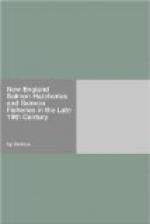It was very doubtful whether they would be congregated about any one spot in sufficient numbers to supply a breeding station, and it would be impracticable to occupy any widely extended part of the river, on account of the difficulties of communication. At the mouth of the river, on the other hand, the supply of adult salmon could be found with certainty, but they must be obtained from the ordinary salmon fisheries in June and held in durance until October or November, and the possibility of confining them without interfering seriously with the normal action of their reproductive functions was not yet established. The latter plan was finally adopted, and in 1871 the first attempt at this method of breeding salmon was instituted by the commissioners’ of Maine, Massachusetts, and Connecticut. The site fixed upon for an inclosure was at Craig’s Pond Brook in the town of Orland, and arrangements for a supply of fish were made with two fishermen of Verona at the very mouth of the river. The salmon first brought were confined in a newly constructed artificial pond in the brook, which was of such remarkable purity that a small coin could be distinctly seen at the depth of 7 feet. All of these died except a few which after a short stay were removed to other quarters. The most prominent symptom was the appearance of a white fungoid growth in patches upon the exterior of the fish. In a lake (locally designated as Craig’s Pond) of equal purity, but greater depth, several of these diseased fish recovered.
Of the salmon later obtained some were placed in an inclosure of nets in the edge of a natural pond with but 7 feet of water, of average purity, some in a shallow inclosure in a brook, and some turned loose in a natural lake of some 60 acres area, with muddy bottom and peat-colored water. In each case the salmon passed the summer with few losses, arrived at the breeding season in perfect health, and yielded at the proper time their normal amount of healthy spawn and milt, though the great sacrifice of breeding fish by the early experiments of the season reduced the crop of eggs to the small number of 72,000.
The conditions of success were thus sufficiently indicated, and in 1872 the same parties, joined with the United States Commission of Fisheries, renewed operations on a larger scale, locating their headquarters at the village of Bucksport, confining the breeding salmon in Spofford’s Pond (Salmon Pond on the general map of Penobscot station), and establishing their hatchery on the brook formed by its overflow. This is the lake of 60 acres in which, as mentioned above, a few salmon had been successfully confined the year before.




